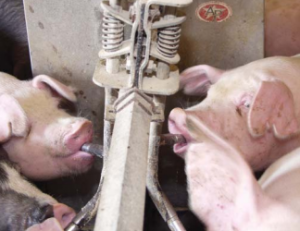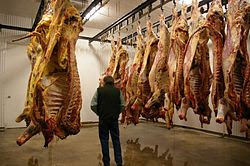Cattle 101: History, Breeds, Fun Facts, Terms
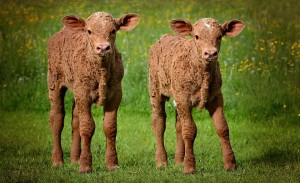
Basic Terms
- Cow: Aadult female that has produced a calf
- Bull: Male animal
- Steer: Male animal that has been castrated and cannot breed
- Heifer: Young female that has not produced a calf
- Veal: Calves that are raised to 475-500 pounds
Over 98% of the beef animal is used when it is processed. About 45% of the animal is used for meat and the rest is used for other byproducts including leather, china, glue, film, soap, pharmaceuticals, insulin, gelatins.
The meat from cattle is called beef. The average American eats about 65 pounds of beef each year.
Fun Facts
• Cattle produce about 25 billion pounds of meat each year.
• The combined value of the cattle and beef industry is $200 billion.
• The hide from one cow can make 144 baseballs, 20 footballs or 12 basketballs.
• Disneyland (CA) sells over 4 million hamburgers each year.
History of Cattle
Not long ago cattle were used for many purposes including meat, milk, and labor. Today beef cattle are raised primarily to provide people with meat, and hundreds of useful by-products. Most cattle graze on grassland that is steep, hilly, dry or rocky and not suitable for building houses or growing crops. The main reason cattle are raised in different climates and settings all over the world is because they can thrive on low quality rangeland feed and grasses.
Cattle are descended from a wild ancestor called the aurochs. The aurochs were huge animals which originated on the subcontinent of India and then spread into China, the Middle East, and eventually northern Africa and Europe. Aurochs are one of the animals painted on the famous cave walls near Lascaux, France. People started domesticating aurochs between 8,000 and 10,000 years ago. Cattle were domesticated after sheep, goats, pigs, and dogs.
Cattle were first brought to the western hemisphere by Columbus on his second voyage to the New World in 1493. Spanish explorer Hernando Cortez took offspring of those same cattle to Mexico in 1519. In 1773, Juan Bautista de Anza brought 200 head of cattle to California to supply the early California missions.
Cattles Amazing Stomachs
Cattle are ruminants. This means they have one stomach with four separate compartments. Their digestive system allows them to digest plant material by repeatedly regurgitating it and chewing it again as cud. This digestive process allows cattle to thrive on grasses, other vegetation, and feed. A cow chews its cud for about eight hours a day. When an animal chews its cud it is a sign of health and contentment. Other ruminant animals include deer, elk, sheep, and goats.
Life Cycle
Many ranchers run cow-calf operations. They keep a herd of cows to produce calves. The cows are bred to calve in the spring or fall. Cows, like humans, are pregnant for nine months.
Newborn
On average a calf will be 70-80 lbs. at birth.
Within the first couple hours after birth, newborn calves will be up and wanting to nurse.
Colostrum, a cow’s first milk after birth, is very important to a newborn and should be consumed as soon as possible.
Colostrum contains antibodies vital for the newborn and has twice the calories of regular milk.
Calves are born with no protection from diseases, so their antibodies come from their mother’s milk.
Calves absorb antibodies from the colostrum directly into their bloodstream through pores in their intestinal lining. Within the first few hours the intestinal walls begin to thicken and the pores close up. By the time they are six hours old they can only absorb a fraction of what they need.
After filling their stomachs calves may feel like bucking and playing.
Calves
For the first three weeks of the calf’s life they only drink their mother’s milk, because their rumen is not yet fully developed. Rumen is one of the stomach chambers in ruminant animals. Humans do not have rumens. Between 3-8 weeks the calf goes through a transitional period where they start eating some hay and grass along with the milk. After eight weeks the calf’s rumen should be fully functioning. The rumen will grow 25 times larger from birth to adulthood.
Tagging, Branding & Earmarks
A newborn calve is commonly tagged. Each ear tag has an individual number which helps ranchers pair the mother with their young and track the calf through its lifecycle. Within the first few months, the calves will be branded. A brand is an identification mark for cattle. It can either be a hot iron brand or a freeze brand. Some operations use earmarks, as an additional way to identify their cattle. During branding all calves are vaccinated to help prevent disease. The young male calves are castrated during the first few months. After castration, they are referred to as steers.
Adulthood – Finishing
Calves are usually sold after they are weaned, at about six-eight months. After weaning, cattle are sent to feedlots for approximately 120 days where they are fed a high-energy ration of grain and hay. After this time called finishing, the cattle are sent to a harvest plant.
To keep the herd size approximately the same, ranchers save replacement heifers (females). The steers (males) will be sent to the feedlot while a few heifers are kept behind to raise and later produce calves themselves. Other heifers will go to the feedlot as well. Steers are more common in the beef industry, because they grow faster and naturally have more muscle.
The ideal breeding age for heifers is at least 14-16 months of age, depending on breed. Heifers should be about 65% of their mature weight before breeding.
Cattle Breeds
There are numerous breeds of cattle raised in the United States. Some breeds have been around for centuries, while others have been developed in the last couple of decades by mixing older breeds. Each breed is characterized by different traits suchs as size, weather tolerance, color, markings, hair length, and temperament.
There are two classifications; Bos indicus and Bos taurus. Bos taurus includes British and Continental. British breeds, also known as English breeds, are smaller in size than Continental breeds. These breeds are the foundation of the United States beef herds. Common English breeds include Angus, Red Angus, Shorthorn, and Hereford.
Continental breeds, also called Exotics, originated in Europe. They are larger in size, lean, muscular, and can tolerate hot climates. Continental breeds include Charolais, Limousin, Simmental, and Salers.
Bos indicus are humped cattle originating from South Central Asia. They are adapted to the stresses of heat, humidity, parasites, and poorly digestible forages. Bos indicus breeds are often found in the southern United States. Common bos indicus breeds are Brahman, Brangus, Beefmaster, Simbrah, and Santa Gertrudis.
Beef Nutrition
Beef is a nutritionally rich food and an excellent source of ten essential nutrients. A three-ounce serving of lean beef contributes more than 10% of the daily recommended value of protein, zinc, vitamin B12, selenium, phosphorous, choline, niacin, vitamin B6, iron and riboflavin. Beef is among the top food sources for protein, zinc and vitamin B12.
Some common types of lean beef cuts include: top sirloin steak, 95% lean ground beef, rib eye steak, T-Bone and tenderloin steak. The U.S. Department of Agriculture’s Nutrient Database shows that many cuts of beef are 20% leaner than they were 15 years ago. Half of the fatty acids found in beef are monounsaturated, the same “good healthy fat” found in olive oil.
Beef By-Products
Besides meat and milk, cows provide us with hundreds of important by-products. Almost the entire beef animal can be used in some way. From a typical 1,000 pound steer, slightly over 40% of the animal is used for retail beef and the remaining 60% is processed into by-products.
Beef by-products are anything made from a beef animal other than meat. You probably use more beef by-products than you think! Some edible examples include margarine, gelatin and marshmallows. Non-edible by-products include leather, soap, cosmetics, crayons and buttons. Cattle also contribute to the health industry. Here are some examples.
Bone, Horn, Hooves, and Gelatin: combs, gelatin candy (Gummy Bears), photographic film, steel ball bearings, fine bone china, pet food, and vitamin capsules/gel coatings.
Hide and Hair: insulation, paintbrushes, glue for bookmaking and band-aides, clothes, shoes, luggage, saddles, furniture, automobiles, volleyballs, basketballs, and baseball gloves.
Fats and Fatty Acids: shampoo, shaving creams, deodorants, candles, crayons, floor wax, detergents, hydraulic brake fluid, plastics, insecticides, paints, perfumes, and synthetic rubber.
Vocabulary Terms
Auroch: the ancient ancestor of domesticated cattle.
Beef By-products: anything made from a beef animal other than meat.
Bovine: scientific name for cattle.
Brand: identification mark on cattle; either hot iron or freeze brand.
Breed: group of animals that have the same ancestry and characteristics.
Bull: a mature male who has not been castrated.
Calf: young animal, either male or female, less than one year.
Calve: to give birth to a calf.
Castration: to remove the testicles of male cattle.
Cow: a mature female that has given birth, usually 2 or more years of age.
Cow-calf operation: a ranch or farm where cows are raised and bred to produce calves.
Cud: the portion of food that an animal regurgitates to chew for the second time.
Dual-purpose: being used for both milk and meat production.
Earmark: identification tool where part of the ear is removed to show ownership.
Feedlot: also know as a feedyard; a type of animal feeding operation used for finishing animals before they are ready for harvest.
Finish: to ready cattle for market, by feeding to a desired weight.
Forages: plant material, mainly leaves and stems, eaten by livestock.
Heifer: a young female cow that has not yet had her first calf. Most heifers have their first calf when they are about two years old, depending on the breed.
Horned: born with horns, usually removed at a young age.
Polled: born without horns, naturally hornless.
Regurgitation: controlled flow of stomach contents back into the throat and mouth.
Roan: an even mixture of white and pigmented hairs, normally red or black.
Rumen: the largest compartment in a ruminants stomach, fermentation and break down of food occurs in the rumen.
Ruminants: mammals that chew cud and have a complex, usually four-chambered stomach.
Steer: a young male calf which has been castrated before reaching sexual maturity. Steers are usually raised for beef.
Tag: a numbered plastic identification tool.
Wean: when a young animal is taken off its mother’s milk.
Yearling: animals approximately 1 year old.

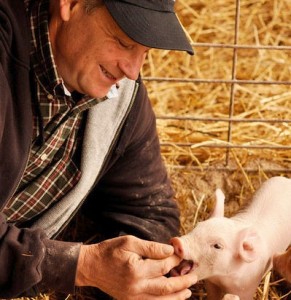

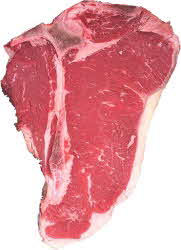
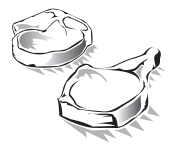





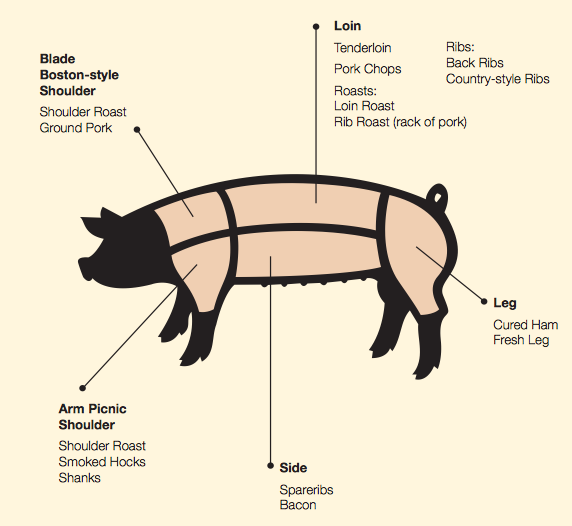
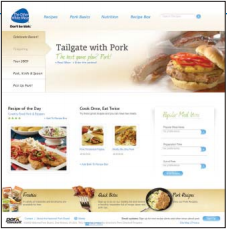
 Did you know that…Women who cut calories but included more protein, including six ounces of lean pork per day, kept more muscle mass while losing weight than women who consumed the same amount of calories but less protein. Consuming a higher-protein diet also helped retain a sense of satiety or fullness after meals, according to the Checkoff-funded project conducted by Purdue University.
Did you know that…Women who cut calories but included more protein, including six ounces of lean pork per day, kept more muscle mass while losing weight than women who consumed the same amount of calories but less protein. Consuming a higher-protein diet also helped retain a sense of satiety or fullness after meals, according to the Checkoff-funded project conducted by Purdue University.
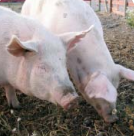
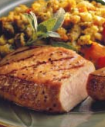
 Fact or hogwash? Pork tenderloin is just as lean as a skinless breast.
Fact or hogwash? Pork tenderloin is just as lean as a skinless breast. Did you know that… As popular as pork is in America, it is not the United States, but China, that is the world’s No. 1 producer and consumer of fresh pork.
Did you know that… As popular as pork is in America, it is not the United States, but China, that is the world’s No. 1 producer and consumer of fresh pork. Did you know that… Pork is the world’s most widely eaten meat.
Did you know that… Pork is the world’s most widely eaten meat.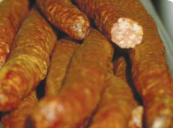
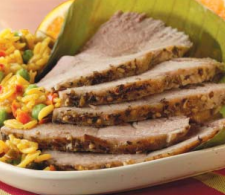







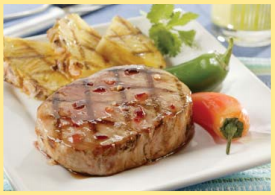
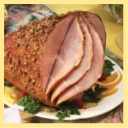
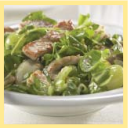




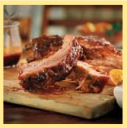







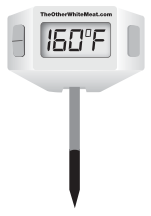 Use an instant-read thermometer to determine when meat is cooked to a safe temperature. Correctly cooked pork is juicy and tender,
Use an instant-read thermometer to determine when meat is cooked to a safe temperature. Correctly cooked pork is juicy and tender, Wash hands, all utensils, containers, cutting boards and work surfaces with warm soapy water for 20 seconds (count to 30) before
Wash hands, all utensils, containers, cutting boards and work surfaces with warm soapy water for 20 seconds (count to 30) before

